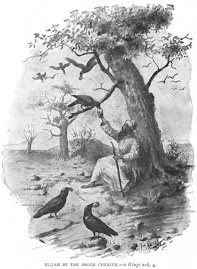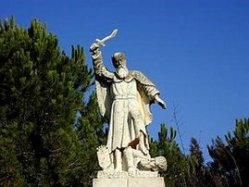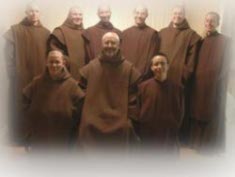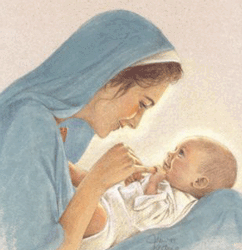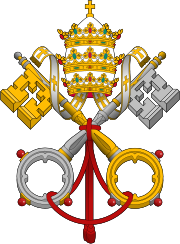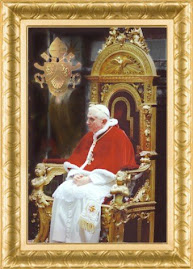Today we continue to meditate on the Beauty of Carmel, Our Lady, ever gracious Protectress of Carmelite Order. Our Lady should be in the heart of every devout Carmelite, she is the example to follow in the Order devotion to her. This truth is often forgotten and neglected nowadays.


In that distress the Saint again had recourse to Mary and his confidence was not betrayed. How could it be otherwise? In the night of the 16th of July, 1251, Mary appeared to the General of the Order, who was in Cambridge at that time.
He was kneeling, as was his wont, far into the night before the statue of Our Lady; from his lips flowed again the devoutly insistent Flos Carmeli. He begged privileges for the Order. In answer to his fervent prayer, Our Lady appeared in the habit of the Order and pointed to it as a pledge of her special protection. Whosoever should die in that habit should not suffer the eternal fire.
This apparition left the Saint enraptured with joy. The Order's habit, hitherto a token of devotion to Mary, now became likewise a pledge of her special protection. The disclosure of this motherly promise in a short time modified the attitude towards the Order. People vied with each other to beg the Order's habit, either to live or to die in it. In receiving the habit of the Order they secured Our Lady's motherly help in those times which were so rich in devotion to Mary. A stronger confirmation of the Marian character of the Order was hardly imaginable and very soon, therefore, it was regarded preeminently as the Marian Order.
It is quite certain that the title became more and more known and recognized, and especially in the Netherlands, where the stock-title of the Order became "Our Lady's Brethren." By that name the Carmelites are usually, nay, nearly always called. This quite outstanding name of Brothers of Our Lady led to a rapid extension of the Order, while at the same time many people living in the world received the habit of the Order to participate in its privileges. In the Order of Carmel, the Scapular supplied the whole habit. Hence, the stamp of Mary was put more and more on the Order.
Our Lady Especially Venerated as Mother of God.
We ought, however, to discuss for a moment the character of the devotion to Mary. This devotion has marks and traits of its own in the Order of Carmel. Whereas in the Order of St. Francis of Assisi Mary's Immaculate Conception is especially regarded, in our own Order attention is focused upon Mary as Mother of God. As such she had already been foreshadowed in the little cloud above Carmel; as such she was honoured on Carmel; and as such she has ever been invoked in our Order. When the first members of the Order looked out from their high mountain towards the country, their looks met first of all Nazareth, and this little town recalled to their minds the coming of the Angel to Mary and the accomplishment of the mystery of the Incarnation in the overshadowing of the Holy Ghost. The contemplation of this mystery has led to a twofold devotion to Mary, which we had better describe as an imitation of Mary, gradually deepening into a closer union with her. We may see the same in the Imitation of Christ in the 14th and 15th centuries, which matured in the 16th century into a close union with Christ. One should not think of the imitation without thinking of the union, nor of the union without the thought of the imitation. Both flow into each other, but in one period the former is more prominent, in another more attention is paid to the latter. One should rather see both trends blended together into one harmonious whole.
Mary Before Us as our Example.
The imitation of Mary, the most elevated of all creatures, set as an example before us by God Himself, shows Mary as the pattern of all virtues. She is the mirror in which we should ever watch ourselves, the Mother whom her children ought to resemble ever more. A remarkable treatise on this has come down to us in the collection of old manuscripts of the first part of our Order's history, collected by the Spanish Carmelite, Philippus Riboti, and printed in the beginning of the 16th century. How old this utterance of devotion towards Mary may be cannot be solved satisfactorily. At any rate, it is older than the end of the 14th century, when it already belonged to old manuscripts. Father Gabriel Wessels ascribes it without any hesitation to the famous English Carmelite, John Baconthorpe, who lived in the early part of the 14th century.
The author gives a brief outline of the Rule of the Order and concludes that the Carmelite, in order to observe this Rule, has only to look at the example of Our Lady. He thinks that our Order is fully entitled to bear the name, Order of Brothers of Our Lady, seeing that Mary already practised before us everything that is prescribed in the Rule. Then he praises her obedience, purity and apostolic poverty. Just as the Order's Rule commanded, she had chosen her places of residence far from the turmoil of the world: in the loneliness of the little house of Nazareth, in the solitary cave of Bethlehem, in the poverty of Egypt. As to the observance of silence, he points out how few words spoken by Mary have been noted down in the Scripture. And thus he goes on with his examples. Sometimes his parallels are somewhat farfetched, but on the whole his explanations are in keeping with the words and intentions of the Rule. All these facts of Mary's life are pictured to the Carmelite in order to show him how he follows Mary's life closely by observing his Rule.
For those interested in Marian Devotion of Discalced Carmelites I invite to read essay on the subject published by General House of Discalced order in Rome and entitled The Virgin Mary in Our Life"
The imitation of Mary, the most elevated of all creatures, set as an example before us by God Himself, shows Mary as the pattern of all virtues. She is the mirror in which we should ever watch ourselves, the Mother whom her children ought to resemble ever more. A remarkable treatise on this has come down to us in the collection of old manuscripts of the first part of our Order's history, collected by the Spanish Carmelite, Philippus Riboti, and printed in the beginning of the 16th century. How old this utterance of devotion towards Mary may be cannot be solved satisfactorily. At any rate, it is older than the end of the 14th century, when it already belonged to old manuscripts. Father Gabriel Wessels ascribes it without any hesitation to the famous English Carmelite, John Baconthorpe, who lived in the early part of the 14th century.
The author gives a brief outline of the Rule of the Order and concludes that the Carmelite, in order to observe this Rule, has only to look at the example of Our Lady. He thinks that our Order is fully entitled to bear the name, Order of Brothers of Our Lady, seeing that Mary already practised before us everything that is prescribed in the Rule. Then he praises her obedience, purity and apostolic poverty. Just as the Order's Rule commanded, she had chosen her places of residence far from the turmoil of the world: in the loneliness of the little house of Nazareth, in the solitary cave of Bethlehem, in the poverty of Egypt. As to the observance of silence, he points out how few words spoken by Mary have been noted down in the Scripture. And thus he goes on with his examples. Sometimes his parallels are somewhat farfetched, but on the whole his explanations are in keeping with the words and intentions of the Rule. All these facts of Mary's life are pictured to the Carmelite in order to show him how he follows Mary's life closely by observing his Rule.
For those interested in Marian Devotion of Discalced Carmelites I invite to read essay on the subject published by General House of Discalced order in Rome and entitled The Virgin Mary in Our Life"




